A verb tense is a grammatical construct that modifies the verb to represent time. Learning the different tenses of verbs will help you express the reality of time in your speech and writing alongside using time expressions.
Keep reading to learn the uses and examples of verb tenses in English as I break it all down. Then, test your understanding by answering the worksheet I created.
What is a Verb Tense?
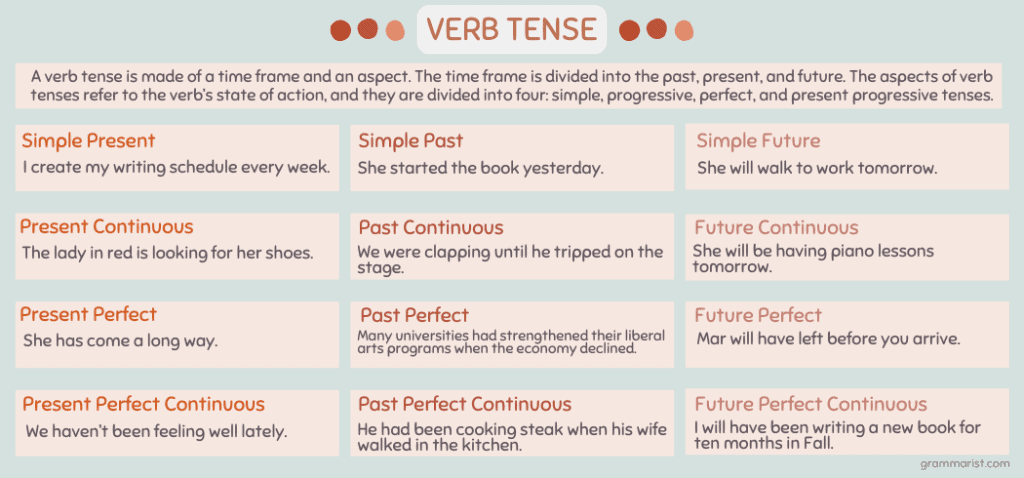
Before understanding what a verb tense is, it helps to recall the definition of verbs. Remember that a verb is a part of speech that shows actions, conditions, and the existence of something while showing time.
A verb tense is made of a time frame and an aspect. The time frame is divided into the past, present, and future.
The past tenses describe actions in the past, while the present tenses describe activities taking place. Meanwhile, future tenses describe an action that will occur in the future. It’s super important to understand the difference in this, especially if you’re writing.
The aspects of verb tenses refer to the verb’s state of action, and they are divided into four: simple, progressive, perfect, and present progressive tenses.
The simple tenses are for actions occurring at a specific time in the past, future, or present. Progressive tenses indicate ongoing or unfinished action, while perfect tenses describe a finished action. Lastly, the perfect progressive tenses show actions in progress then finished.
How Do You Identify Verb Tenses?
You can understand the types of verb tenses by mastering their different forms. For instance, you should know that the simple past tense usually has a verb that ends in -d or -ed if they are regular verbs.
For progressive tenses, there is an auxiliary verb followed by the present participle verb. The present participle form is also the -ing form of the verb. All of these forms locate an event in time.
It also helps to understand verb tense rules, such as the proper sequence of verb tenses. For example, the verb of the subordinate clause can be in any tense if the independent clause shows future or present tense.
Remember to only show shifts in verb tenses when necessary, such as when you indicate a change in the time of the action.
I find that style guides also vary when it comes to verb tense rules. There may be examples of writing rules in APA that Chicago does not recommend.
What are the 12 Verb Tenses?
Now, let’s discuss the twelve English tenses, their functions, and some sentence examples. I’ve divided them into key sections to make things easier.
Simple Present
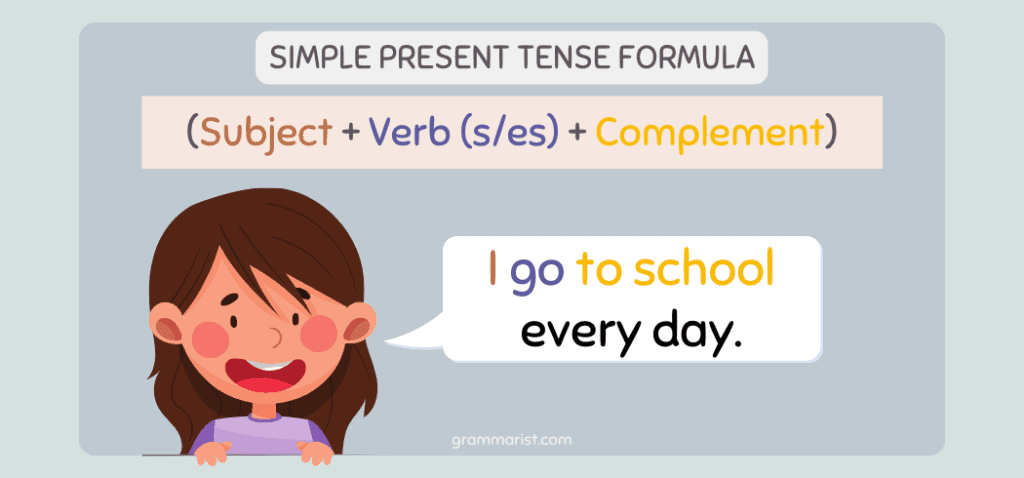
The simple tense is the first big category of verb tenses. The simple present tense shows actions or being that are either happening at the moment or regularly.
We form the simple present tense by adding -s or -es if the subject is singular. But if the subject is plural or I, keep it in its base form. For example:
- I create my writing schedule every week.
- She creates her writing schedule every week.
- They create their writing schedule every week.
Present Continuous
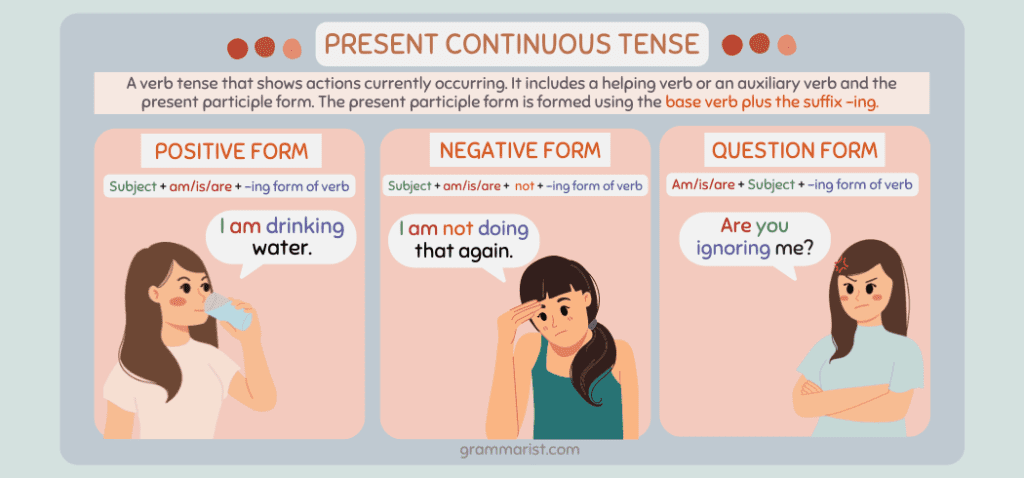
The present continuous or progressive tense is one of the categories of verb tenses that shows an ongoing action at present. Professional writers also use this verb tense to express habitual action.
We form the present continuous tense using an auxiliary verb in the present tense is/are/am + –ing verb form. For example:
- The previous researchers from Purdue University who wrote thermodynamics are now writing a paper about aerodynamics.
- The lady in red is looking for her shoes.
To understand this verb tense better, we must know the difference between continuous, non-continuous, and mixed verbs. Remember that non-continuous verbs or stative verbs like remember, hate, guess, and seem do not use the present continuous tense. For example:
- Incorrect: I am hating this movie.
Correct: I hate this movie.
Present Perfect
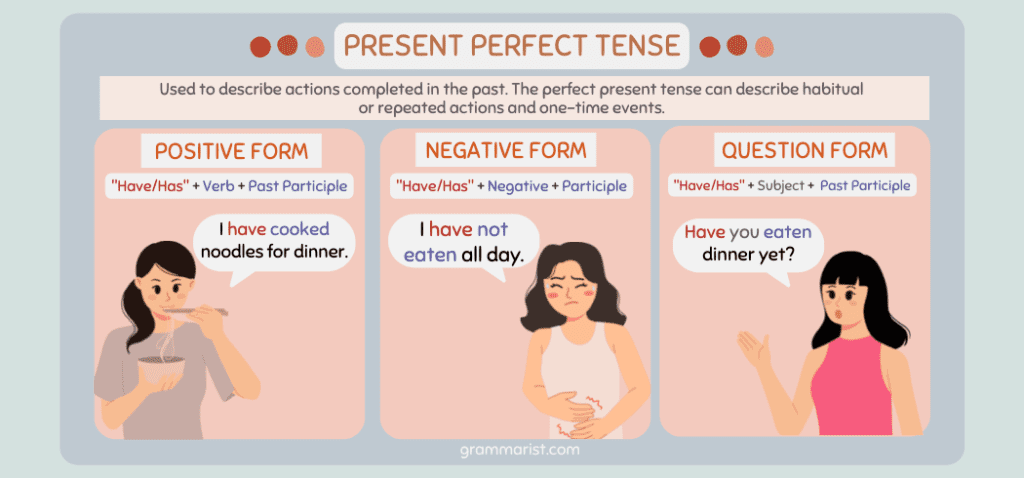
The perfect verb tenses show actions with complex time relationships. They are either complete, perfected, or finished.
The standard present perfect tense is one of the perfect tenses that shows past actions that continue or are related to the present. They may also show actions recently finished or completed in the past at an indefinite time.
We form it using the popular auxiliary verb, has or have, and the past participle verb form. For example:
- They have come a long way.
- She has come a long way.
Present Perfect Continuous
The present perfect continuous tense shows actions that started in the past and are continuing in the present. This verb tense follows the formula has/have been + present participle of the verb. For example:
- Arnold has been playing the piano recently.
- We haven’t been feeling well lately.
Simple Past
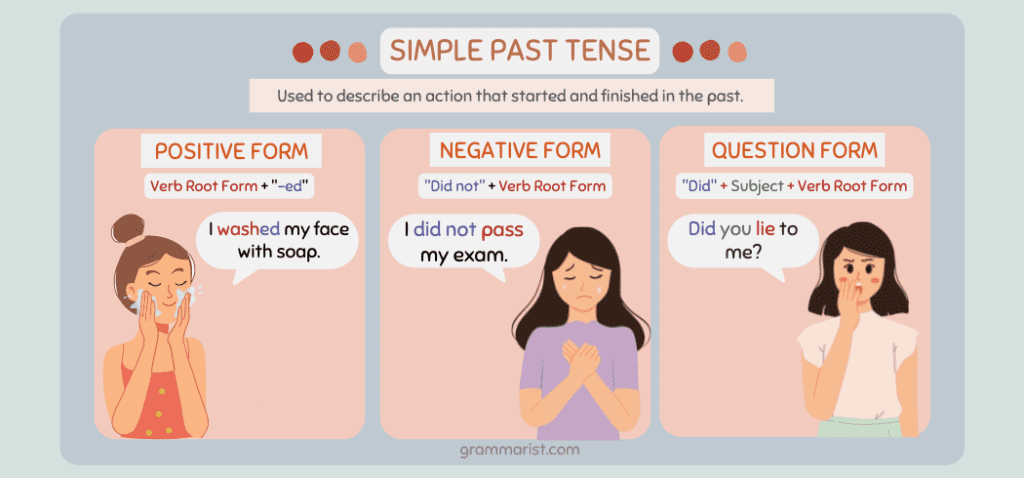
This tense is one of the English verb tenses that show past actions, whether it’s a specific or nonspecific time. They are sometimes formed by adding -d or -ed to the base verb. For example:
- She started the book yesterday.
Some verbs in the simple past form are irregular. An Irregular verb is one of the types of verbs that do not follow the typical simple past and past participle form of verbs. For example:
- We bought new curtains yesterday.
Past Perfect
The perfect aspect of verbs shows perfected or completed action at a specific time.
The past perfect tense is one of the major verb tenses that discuss actions completed before a specific event in the past. Past perfect tense forms require a verbal phrase that includes had and the past participle of the verb. For example:
- Many universities had strengthened their liberal arts programs when the economy declined.
Past Continuous
The past continuous tense shows a continuing action happening at a specific point in the past. We form it by using was/were + -ing form of the verb. For example:
- We were clapping until he tripped on the stage.
- My mom was baking cookies when my friend knocked.
Past Perfect Continuous
The past perfect continuous expresses an action initiated in the past and continued until later in the past. We form it using had been and the present participle form of the verb. For example:
- He had been cooking steak when his wife walked in the kitchen.
Simple Future
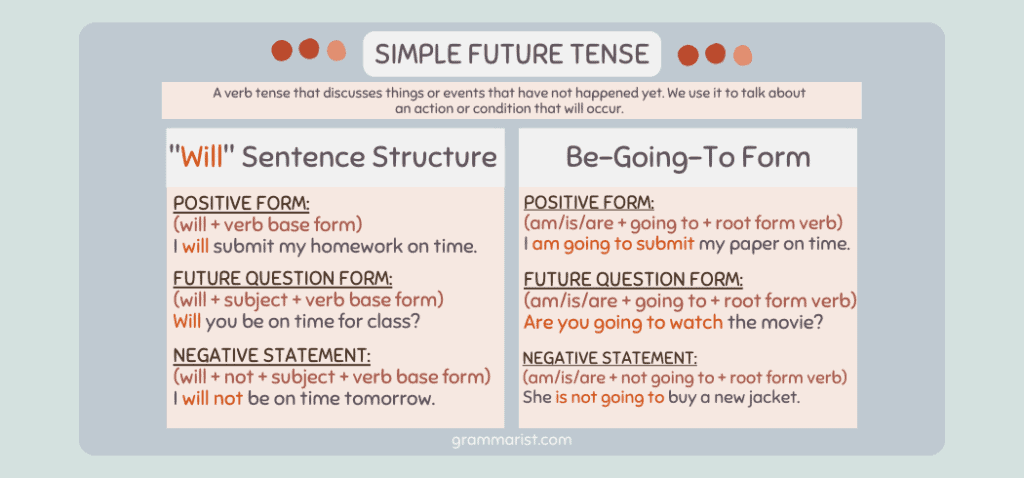
The future tense verbs express actions in future events or the future state of being of something.
We form the simple future tense through the verb phrase will plus the root verb. Will is a helping verb that assists the main verb to show the future time, whether it’s a determinate or indeterminate time. It’s one of the modal verbs aside from shall, would, can, etc.
Some examples include will write, will look, will wash, and will buy. Below are some sentence examples that show future action.
- The researcher will submit his paper to the University of Michigan Press tomorrow afternoon.
- She will walk to work tomorrow.
Future Continuous

The future continuous or progressive tense describes an event that is ongoing in the future. Such action is expected to continue over a period of time. Therefore, it’s a future continuous action.
We form a future continuous verb by using will be plus the –ing form of the verb. For example:
- I will be going to the library while you do your homework.
- She will be having piano lessons tomorrow.
Future Perfect
The future perfect tense is for actions that will be finished before another event in the future. This is formed by using the words will + have + past participle of the verb. For example:
- Before school begins in the Fall, they will have gained enough motivation to decide which university they want to attend.
- Mar will have left before you arrive.
Future Perfect Continuous
The future perfect continuous describes an action that will continue in the future. The correct formula is will have been + present participle form of the verb. For example:
- I will have been writing a new book for ten months in Fall.
What are Present Perfect Infinitives?
Infinitives are usually expressed in simple tenses, but they also have perfect tense forms. They occur when the infinitive has the word have before it. Some verbs, such as plan and expect, lead to issues when these future verbs are used with infinitives.
In the sentences below, the actions are expressed in the past. Therefore, they use the simple past verb forms.
- I intended to listen to the new song.
- Ian meant to visit his adviser.
Verb Tenses vs. Time Reference
Verb tenses refer to the grammatical structure of the verb. Meanwhile, the time reference is when the action takes place. Some verb tenses can show a single time reference. Sometimes, different time references use one verb tense.
Can the Verb Tenses Be Expressed in Different Forms?
You can show verb tenses in active and passive verb forms. Negative, affirmative, and interrogative forms also exist in different verb tenses.
What’s the Most Used Verb Tense in English?
The most common verb tenses are simple tenses, especially the simple present and simple past. The present perfect tense is also common in the English language. You’ll find these tenses in both creative and academic writing.
It’s also essential to differentiate between the tenses and mood of verbs. Verbs have three moods: imperative, subjunctive, and indicative.
Verb Tenses Summary
The different verb tenses show any action or condition’s location in time. They include the past, future, and present tenses.
Use different verb tenses to clarify several time periods. Make sure to observe consistency and accuracy in these tenses for verb usage.